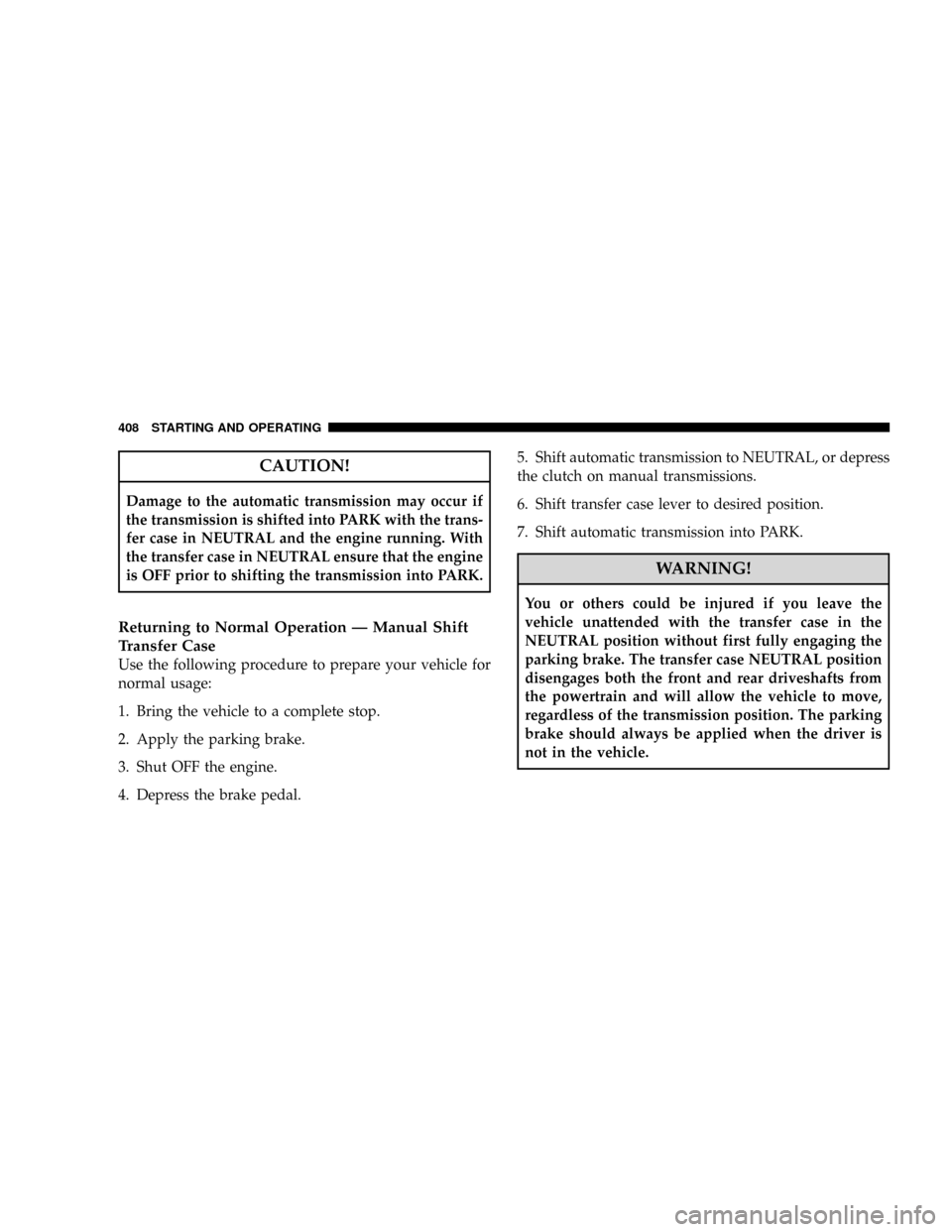Page 399 of 554
WARNING!
Any work done to the vehicles electrical system, or
wiring, should be performed by a qualified automo-
tive technician, if done improperly it may cause
damage to the electrical system wiring and could
result in serious or fatal injury.
7-Pin Connector
STARTING AND OPERATING 397
5
Page 403 of 554
SNOWPLOW
Snowplow Prep Packages are available as a factory-
installed option. These packages include components
necessary to equip your vehicle with a snowplow.
1500 Models (Light Duty)
NOTE:Do not use 1500 (light duty) Models for snow-
plow applications.
WARNING!
On 1500 Models, snowplows, winches, and other
aftermarket equipment should not be added to the
front end of your vehicle. The airbag crash sensors
may be affected by the change in the front end
structure. The airbags could deploy unexpectedly or
could fail to deploy during a collision resulting in
serious injury or death.
Trailer Towing Position
STARTING AND OPERATING 401
5
Page 404 of 554
CAUTION!
Using 1500 Model vehicles for snowplow applica-
tions can cause damage to the vehicle.
NOTE:Before installation of a snowplow, it is highly
recommended that the owner/installer obtain and follow
the recommendations contained within the current
Dodge BODY BUILDER'S GUIDE. See your authorized
dealer, installer or snowplow manufacturer for this infor-
mation. There are unique electrical systems that must be
connected to properly assure operator safety, and to
prevent overloading vehicle systems.
WARNING!
Attaching a snowplow to this vehicle could adversely
affect performance of the airbag system in an acci-
dent. Do not expect that the airbag will perform as
described earlier in this manual
CAUTION!
The ªLamp Outº indicator could illuminate if exte-
rior lamps are not properly installed.
402 STARTING AND OPERATING
Page 410 of 554

CAUTION!
Damage to the automatic transmission may occur if
the transmission is shifted into PARK with the trans-
fer case in NEUTRAL and the engine running. With
the transfer case in NEUTRAL ensure that the engine
is OFF prior to shifting the transmission into PARK.
Returning to Normal Operation Ð Manual Shift
Transfer Case
Use the following procedure to prepare your vehicle for
normal usage:
1. Bring the vehicle to a complete stop.
2. Apply the parking brake.
3. Shut OFF the engine.
4. Depress the brake pedal.5. Shift automatic transmission to NEUTRAL, or depress
the clutch on manual transmissions.
6. Shift transfer case lever to desired position.
7. Shift automatic transmission into PARK.
WARNING!
You or others could be injured if you leave the
vehicle unattended with the transfer case in the
NEUTRAL position without first fully engaging the
parking brake. The transfer case NEUTRAL position
disengages both the front and rear driveshafts from
the powertrain and will allow the vehicle to move,
regardless of the transmission position. The parking
brake should always be applied when the driver is
not in the vehicle.
408 STARTING AND OPERATING
Page 414 of 554

NOTE:Steps 1 through 5 are requirements that must be
met prior to depressing the transfer case Neutral (N)
button, and must continue to be met until one second
elapses and the shift has been completed. If any of these
requirements (with the exception of step 3 - key ON) are
not met prior to depressing the Neutral (N) button, or are
no longer met during the one second time, then all of the
mode position indicator lights will flash continuously
until all requirements are met, or until the Neutral (N)
button is released.
NOTE:The ignition key must be ON for a transfer case
shift to take place and for the position indicator lights to
be operable. If the key is not ON, the shift will not take
place and no position indicator lights will be on or
flashing.NOTE:Flashing Neutral position indicator light indi-
cates that shift requirements have not been met.
WARNING!
You or others could be injured if you leave the
vehicle unattended with the transfer case in the
NEUTRAL position without first fully engaging the
parking brake. The transfer case NEUTRAL position
disengages both the front and rear driveshafts from
the powertrain and will allow the vehicle to move
despite the transmission position. The parking brake
should always be applied when the driver is not in
the vehicle.
412 STARTING AND OPERATING
Page 417 of 554
WHAT TO DO IN EMERGENCIES
CONTENTS
mHazard Warning Flasher..................416
mJacking And Tire Changing................417
NJack Location........................417
NReinstalling The Scissors-Type Jack And Tools
(1500 Models)........................419
mJacking Instructions.....................422
NRemoving The Spare Tire................422
NTire Changing Procedure................423mHoisting.............................434
mJump-Starting Procedures.................434
mFreeing A Stuck Vehicle..................437
mEmergency Tow Hooks Ð If Equipped........438
mTowing A Disabled Vehicle................439
N4-Wheel Drive Vehicles.................439
N2±Wheel Drive Vehicles.................439
6
Page 418 of 554
HAZARD WARNING FLASHER
The Hazard Warning switch is mounted on the top of the
steering column as shown in the illustration.To engage the Hazard Warning lights, depress the button
on the top of the steering column. When the Hazard
Warning switch is activated, all directional turn signals
will flash off and on to warn oncoming traffic of an
emergency. Push the button a second time to turn off the
flashers.
This is an emergency warning system and should not be
used when the vehicle is in motion. Use it when your
vehicle is disabled and is creating a safety hazard for
other motorists.
When you must leave the vehicle to seek assistance, the
Hazard Warning lights will continue to operate even
though the ignition switch is OFF.
NOTE:With extended use, the Hazard Warning lights
may discharge your battery.
Hazard Light Warning Switch
416 WHAT TO DO IN EMERGENCIES
Page 419 of 554
JACKING AND TIRE CHANGING
WARNING!
²Being under a jacked-up vehicle is dangerous. The
vehicle could slip off the jack and fall on you. You
could be crushed. Never put any part of your body
under a vehicle that is on a jack. Never start or run
the engine while the vehicle is on a jack. If you need
to get under a raised vehicle, take it to an authorized
service center where it can be raised on a lift.
²The jack is designed to use as a tool for changing
tires only. The jack should not be used to lift the
vehicle for service purposes. The vehicle should
be jacked on a firm level surface only. Avoid ice or
slippery areas.
Jack Location
The jack and jack tools are stored under the front passenger
seat. Lift the flap on the side of the seat for access.
Removal (2500/3500/Mega Cab)
Remove the jack and tools by removing the wing bolt and
sliding the assembly from under the seat.
Jack Location
WHAT TO DO IN EMERGENCIES 417
6